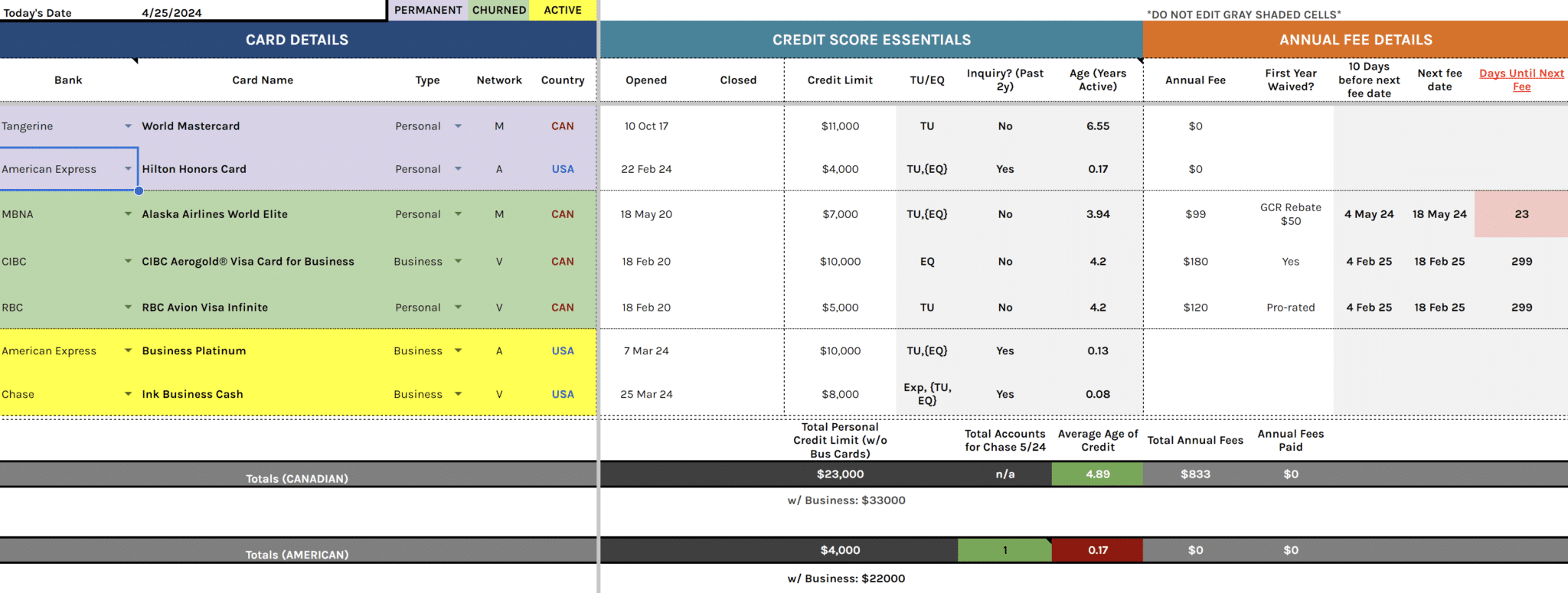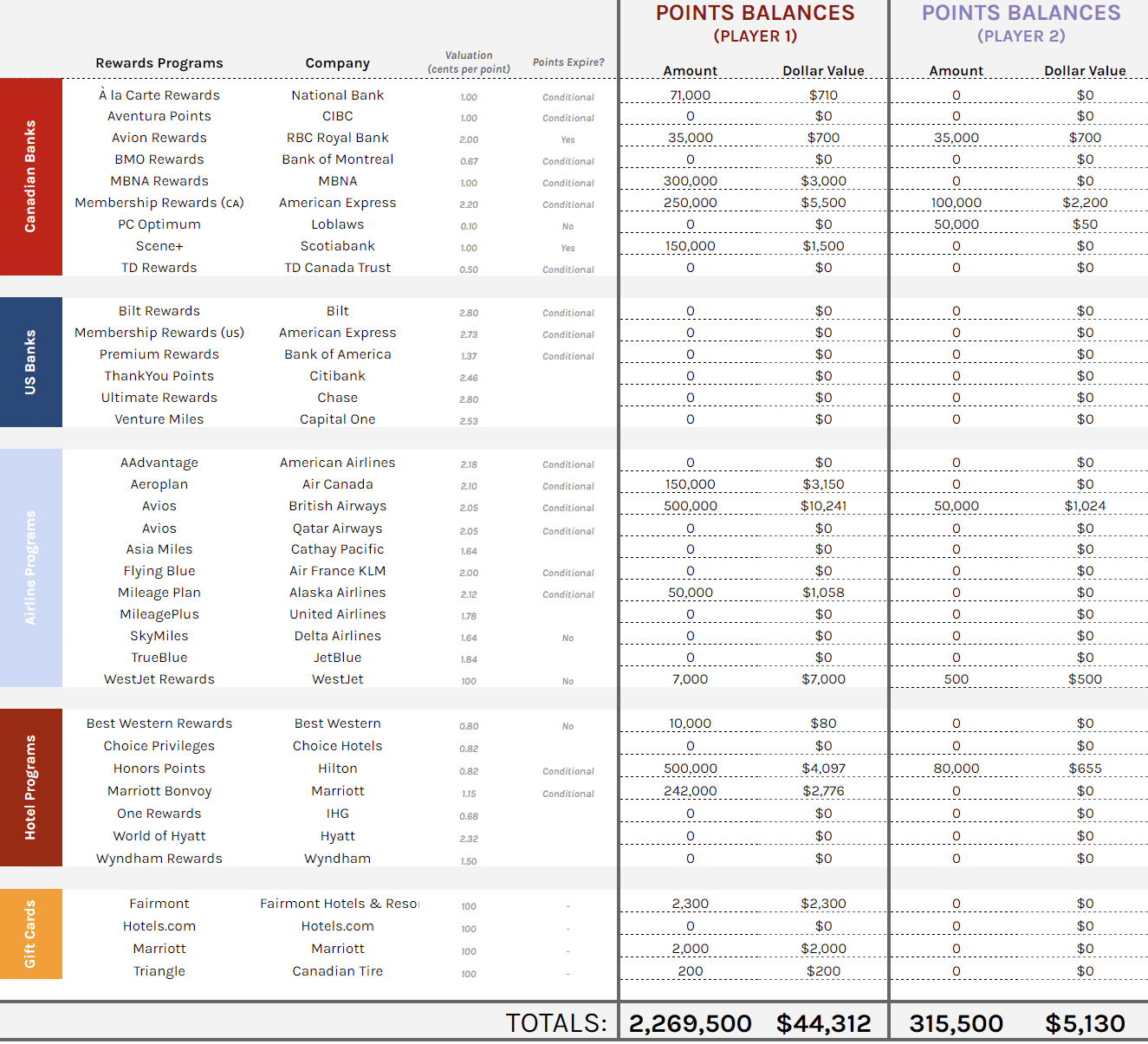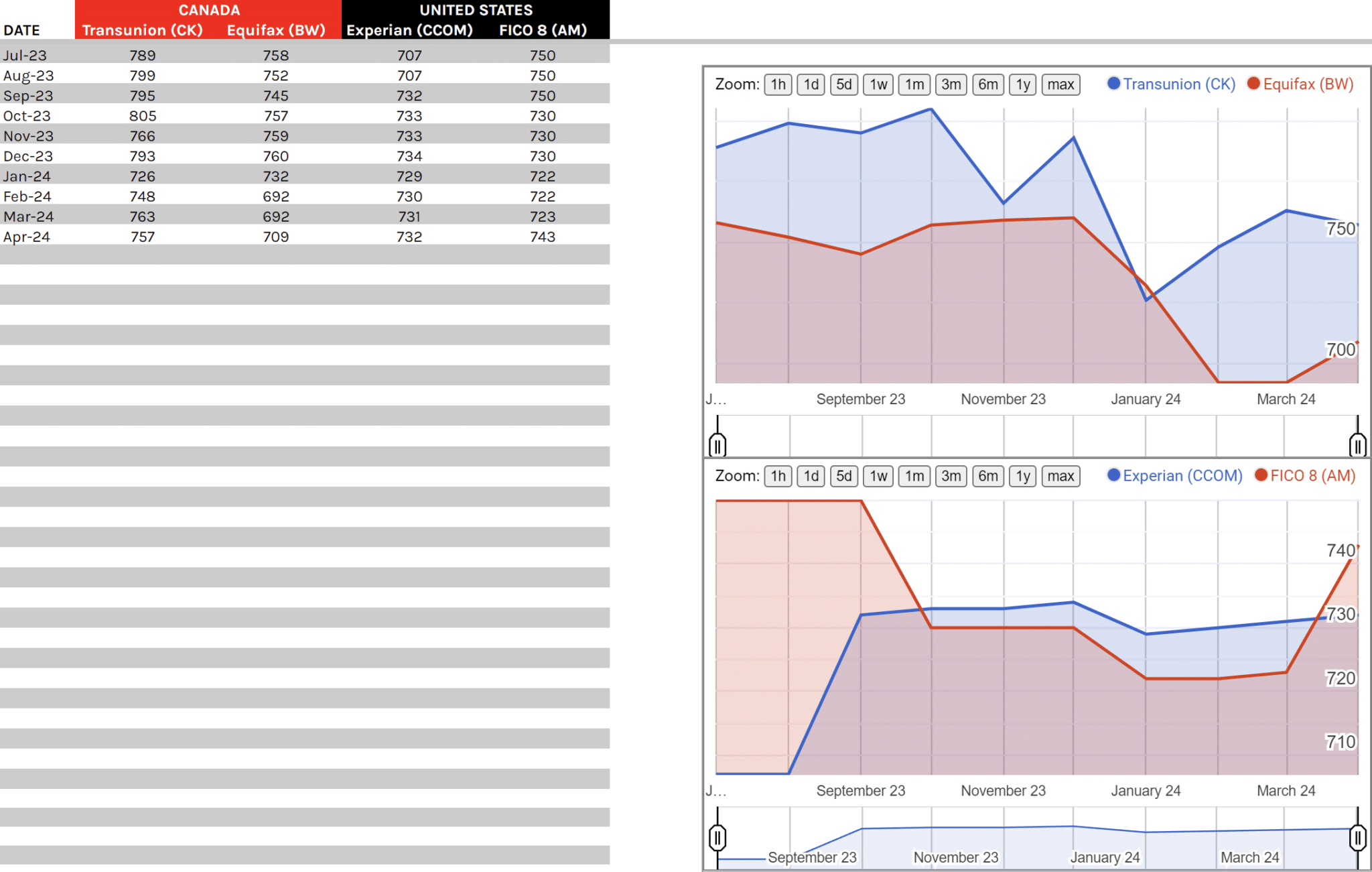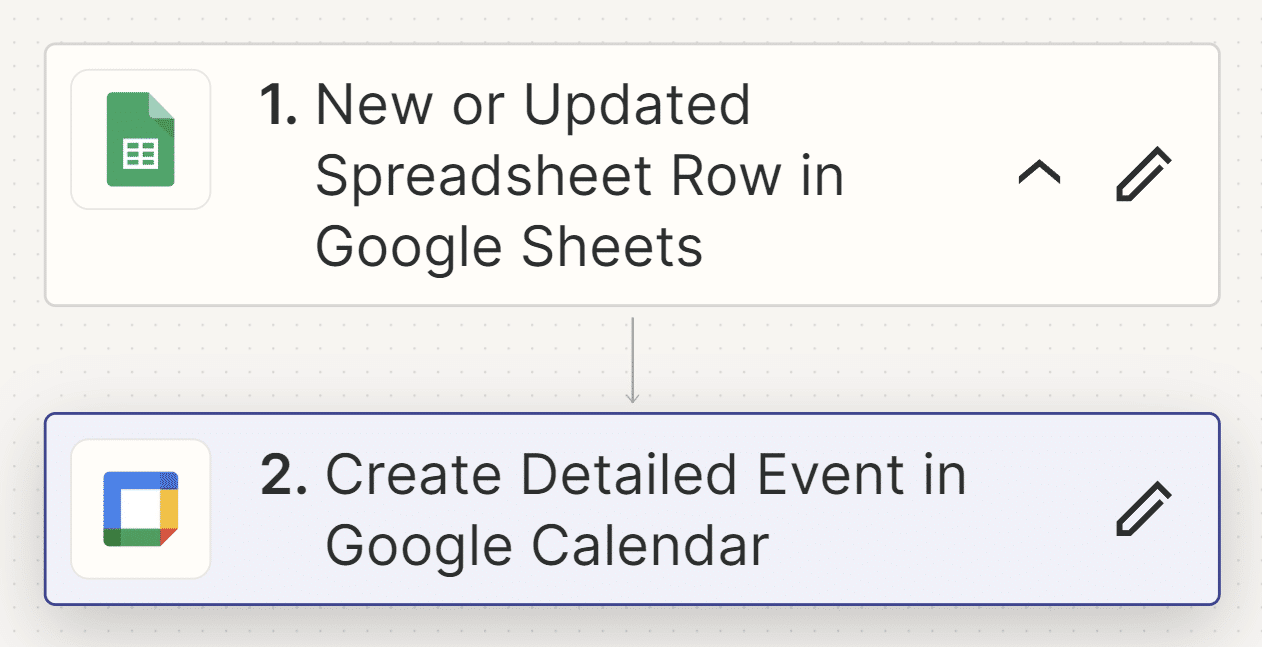Success in miles and points requires going beyond the beginner stages of applying for one or two credit cards. It requires a high level of organization and thus necessitates having a system for keeping track of credit cards, accounts, and points balances.
Guide: Miles & Points for Beginners
In this article, I outline several different approaches to tracking your credit cards and points balances, including automated and manual approaches. I also include a template of the specific spreadsheet I use to track everything.
Tracking Credit Cards
By far, the most popular solution among miles and points enthusiasts is a good ol’ fashioned Excel spreadsheet (whether Microsoft Excel offline or my preference, Google Sheets). Spreadsheets are easy to create and customize to your exact needs, and have no/low risk of your data being compromised.
Beyond spreadsheets, there are highly niche solutions to credit card tracking in the form of web applications. These include:
I’ve tried out some of these applications, and they offer good solutions with a more user-friendly way to automate your card tracking that doesn’t require any technical expertise. That being said, they still don’t offer the flexibility of the legacy spreadsheet.
Furthermore, if you’re a proficient Excel user, you can implement very advanced features into your spreadsheet and reproduce almost everything these applications currently offer.
The companies offering these applications also tend to go out of business. It’s nice to have the peace of mind that your tracking system is going to be future-proof, which is the case with something like a spreadsheet.
My Tracking Sheet
Since I began collecting miles and points, I’ve iterated over my own Google Sheet frequently. It now gives me a great system for tracking my credit cards and having an overview of how my miles and points are doing.

In full transparency, I adapted this sheet from one created by Johnny Africa. However, the original version was a tad complex and designed with US credit cards in mind. I have since modified and simplified the sheet to track both Canadian and US credit cards, from the perspective of a Canadian.
Related: Guide to US Credit Cards for Canadians
Let’s go over the features of the spreadsheet below.
Features
Inventory
The main tab of the sheet for tracking is the ‘Inventory’ tab, which tracks all open and closed credit cards. The Inventory requires about 15 fields to be entered when you add a new entry, while the rest of the fields are either optional or auto-calculated for you (shaded in gray).
It includes several sections:
- Card Details: Bank, Name, Type, Network, Country
- Credit Score Details: Opened Date, Closed Date, Credit Limit, Credit Inquiry and Account Age
- Annual Fee Details: Annual Fee, First Year Waived, Date 10 days before next fee, Date of next fee, Days until next fee
- Welcome Bonus Details: Rewards Name, Bonus, Minimum Spend, Time Frame (days), Estimated Value, Days Until Bonus Expires, Spend Met (checkbox), and Date Bonus Received
- Card Benefits (Optional): FX Fees, Statement Close Date, Last 4 Digits, Expiry Date, Card Benefits, Lounge Access, Best Way to Redeem Rewards, When to Use the card?, Keep Card Past 1y?
- Application Information (Optional): Name, Email, Employment, Income, Registered Business
Minimum spend tracking and completion is a key component of what I use this sheet for. I record when a spend has been completed and the actual date the bonus was received. However, while a minimum spend is in progress, I record the actual individual transactions and total progress towards the spend in a separate notes application, not in this sheet.
I use color-coding to distinguish what state different cards are at, as follows:
- Yellow: Active – This means the card is currently in progress toward a bonus.
- Green: Complete – Once a minimum spend is complete and the bonus is awarded, it is considered complete. This is used for cards in ‘limbo’ before I ultimately decide to renew or cancel around the anniversary date.
- Purple: Permanent – Used to identify a ‘keeper’ card that I intend to hold indefinitely. These are typically cards without an annual fee.
The last two sections, Card Benefits, and Application Information are optional. You may find the former useful to remind you what the card is best used for and to identify the card if you have multiple of the same card at the same bank. I also like to enter the specific details I entered at the time of application, like my employment, income, and if I applied under a business name.
Other Features
I use the tracking sheet for several other purposes, including tracking my points balances, credit scores, and consumables (certificates, passes, free night awards, etc).

The points balances are done in a very rudimentary way, and require manual updating. I added a plethora of programs to this template, including Canadian and US Bank-issued programs, airline programs, hotel programs, and even gift cards. Feel free to add or remove programs from this sheet depending on which miles and points you tend to accumulate.

The Credit Score tab helps me keep track of another piece of data that is important to know: my credit score. I have configured mine for both Canada and the US, using Credit Karma and Borrowell in Canada, and Credit.com and the American Express FICO dashboard in the USA. I update the scores about once every one or two months.
Related Reading:
- Credit Scores: Everything You Need to Know
- Borrowell vs Credit Karma: Which Is Best?
- How to Build Credit History in the US, for Canadians
Notably, you can also utilize ClearScore in Canada to track your TransUnion credit score.
Finally, I have a tab called Consumables that helps me keep track of things like free night certificates, annual and quarterly Amex credits, companion passes, and so on. This tab is fairly self-explanatory.
Adding Additional Players
We know having a partner or multiple players in your miles and points strategy is of huge benefit. If you’re lucky enough to have a Player 2 (or 3 or 4), you may choose to track their points and credit cards separately or along with your own.
Related: Convincing a Player Two to Collect Miles & Points
One solution would be to simply duplicate the Inventory tab and label it for each Player. This has been my approach in the past.
On the other hand, if you prefer to have all the cards your household manages on one sheet, I have created an additional version of the Inventory tab called ‘Inventory – Multiplayer’. You can find it under View → Hidden sheets in the Google Sheets menu. It has an additional, filterable column called ‘Player’, and the formulas have been adjusted to calculate totals for each player separately.
Automatic Reminders for Annual Fees
In the past, I manually set up Google Calendar events to remind myself of card anniversary dates (the date in column ‘Next fee date’).
However, this seemed ripe for automation and indeed there are several options for automating the creation of calendar reminders from a Google Sheet.
One sleek solution is to use a service called Zapier.com to create a ‘Zap’ connecting Google Sheets to your Google Calendar.

For this, you’ll need to create an account and configure the Zap to your own calendar and sheet. You’ll want to set the Trigger Column to be Column N or O, related to the fee date.
Then, I set the Calendar Event to be created with the following settings:
- Start Date: Column N (10 Days before the next fee date)
- End Date: Column N (10 Days before the next fee date)
- All day: True
- Use Default Reminders?: false
- Reminders: email
- Minutes Before Reminders: 0
Of course, you can customize the specific settings to fit your own workflow as desired.
Aside from Zapier, if you’re tech-savvy there are some other solutions such as Google Apps Scripts which can also achieve this automation (and more).
Download
Access My Tracking Sheet (Google Sheets) >
I’ve shared the spreadsheet as a public ‘read-only’ file. Click File → Make a copy to take ownership of your own version of the sheet.
To download for offline use, click File → Download as → Microsoft Excel.

Bonus: r/Churning Tracker Template
Access r/Churning Tracker Template >
While my sheet is designed for Canadians who may dabble in US credit cards, there are some US-specific spreadsheets that have been shared online. The sheet linked above is provided by the subreddit r/Churning.
If you’re deep in the US credit card game, or have an SSN for example, this sheet may be of interest as it is designed to help you navigate the complex anti-churning rules in the US. It also has many other tabs including tracking for Inquiries, Referrals, Redemptions, and more. A bit complex for my needs, but interesting regardless.
Future Improvements

While this spreadsheet is extremely handy for me, there is always room for improvements to be made. For me personally, there are a few features I’d like to implement in the future:
- This sheet helps me track existing card applications but doesn’t help with planning new applications or optimizations between existing products, like Product Switching. For example, knowing a given card could be applied for (or switched to) every X number of months, it would be nice to have a planner or system for tracking future applications. Currently, I just have a repeated Google calendar event.
- While I track the overall status of minimum spend requirements for each card in this spreadsheet, it doesn’t help with the granular tracking of my progress toward the minimum spend, in terms of the amount spent or the amount remaining. This would be helpful. Instead, I’m using a rudimentary notes app to track transactions and minimum spend progress.
- Automating the tracking of my points balances, or tracking redemptions and then having that auto-update my points balances, would be a nice-to-have feature as well.
The sheet has gone through a few iterations now, so I have no doubt I will implement more features in the future to simplify my miles and points tasks. I’ll be sure to update this article when that happens.
Tracking Points Balances
On the topic of tracking point balances, there are a few options out there if you’re looking for something more sophisticated than a simple spreadsheet.
One option is AwardWallet. AwardWallet lets you connect your credit cards, hotel and airline loyalty programs, and then will automatically monitor and track all your points balances. It even tells you when your points will expire and if they’re set to expire soon.

The basic version of AwardWallet is free, while the Plus version costs $30 USD per year. The Plus version is faster, has more program information, and includes the points expiry information.
If you’re worried about providing a third party with your login information, AwardWallet allows you to store your passwords locally on a file and then do manual refreshes, instead of storing the sensitive information on AwardWallet’s server.
Another tool I’ve heard great things about is MaxRewards. Not only will it track your points balances similar to AwardWallet, but it helps optimize your credit card spend, card-linked offers, and more. MaxRewards currently only supports US credit cards, however.
Conclusion
At present, I am happy with my Google Sheets solution for tracking my credit cards and points. I would rather depend on a proven solution that relies on the Google Suite, which is unlikely to change or cease to be maintained.
I hope sharing the above helps you even a little bit on your way to a bountiful points haul and lots of award travel. Let me know in the comments if you have any questions, suggestions for improvements, or features you’d like to see!
Reed Sutton
Latest posts by Reed Sutton (see all)
- Review: Singapore Airlines Business Class (A350-900) - Jun 21, 2024
- Review: Turkish Airlines Business Class (777-300ER) - Jun 17, 2024
- Miles Ahead: The Canadian Points Podcast – Now Available! - Jun 7, 2024
- How to Track Your Miles, Points, and Credit Cards: From Spreadsheets to Software - May 13, 2024
- Award Flight Search Tools Compared: AwardTool, Point.me, PointsYeah, Roame, Seats.aero - Apr 22, 2024

